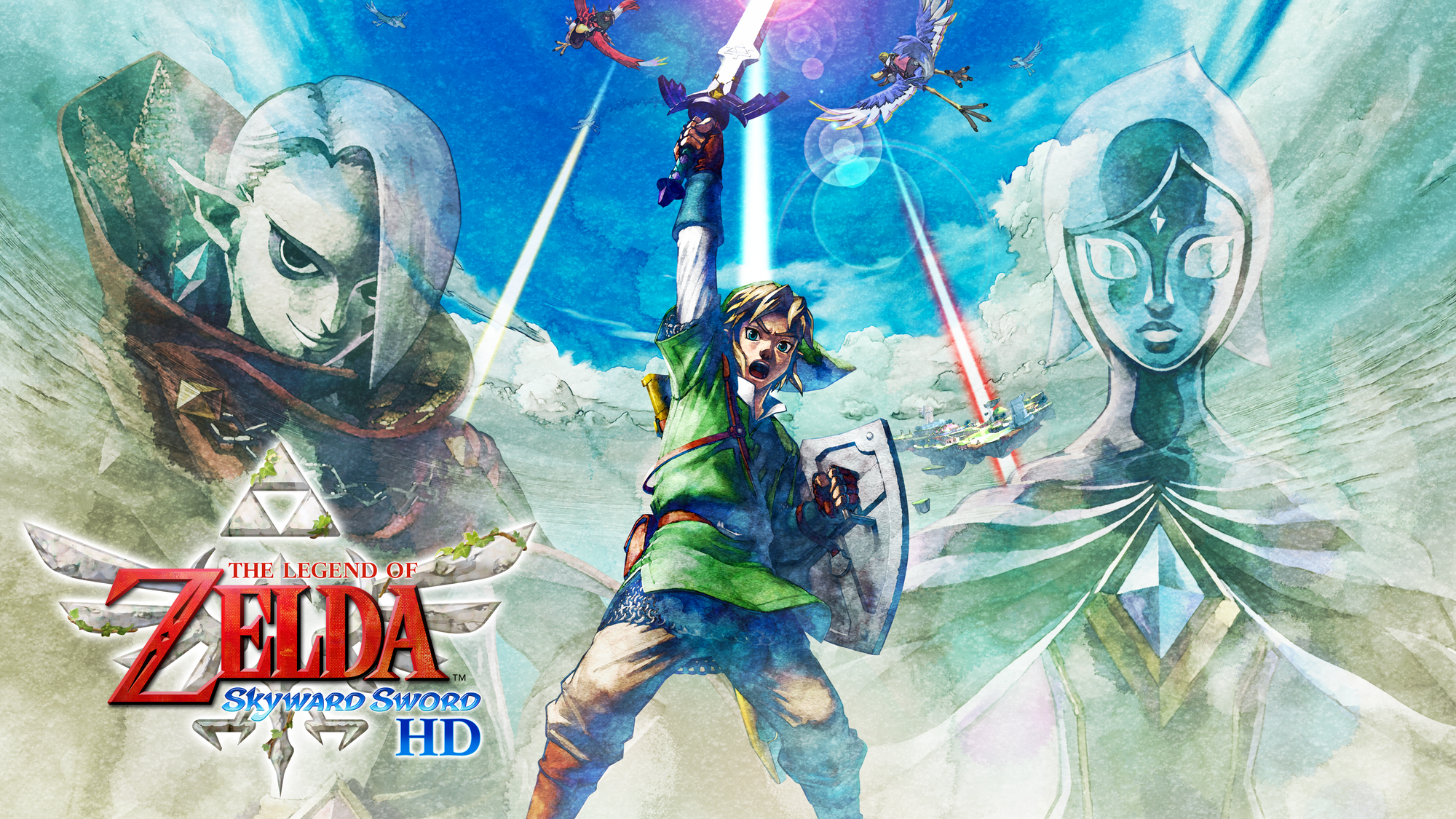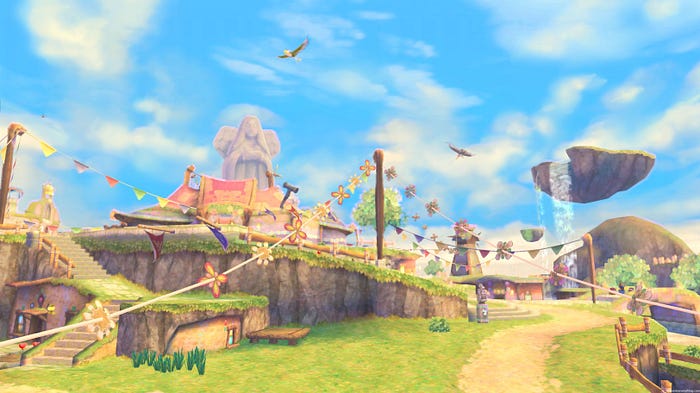The Controversial Zelda You May Have Missed
While Skyward Sword’s motion controls might be a little odd, you owe it to yourself not to miss this outstanding game

Avid gamers have a unique kind of dilemma, especially when it comes to owning too many games and especially when many of those games are partially completed. I must admit that I represent an egregious example of this first-world problem. Right now, I’m oscillating between Bloodstained: Curse of the Moon 2, Uncharted: The Lost Legacy, Ghost of Tsushima, and Paper Mario: The Origami King. Phew!
Balancing several big games simultaneously (while somehow holding down a full-time job) is a big enough ask, and yet I manage to add insult to injury by occasionally pausing to browse my game library, in search of a hidden gem; perhaps something I bought and never played (yes, I’m guilty of that too) or maybe a game I played and didn’t finish (when a highly-anticipated new game is released, I just may drop what I’m currently playing and move on to that).
Lo and behold, my dust-covered Wii contained a little gem that I had almost forgotten about at the time of its release: The Legend of Zelda: Skyward Sword. How could I forget about Zelda of all things? As you’ll see if you explore my work on SUPERJUMP, I’m a huge Nintendo enthusiast. Perhaps I was distracted back then by Super Mario 3D Land and Uncharted 3: Drake’s Deception. See? Prison of choices.

Gimmick, revelation, or unfulfilled promise?
Prior to firing up Skyward Sword, I hadn’t played the Wii in a very long time. I’ve been playing quite a bit of Wii U, but this has mostly involved games that use the GamePad controller rather than the Wii Remote. So it’s been a while since I flicked and waggled my way through a game.

For the uninitiated, Skyward Sword requires either the Wii MotionPlus controller (essentially a second-generation Wii Remote with additional sensors on board) or a Wii Remote with the MotionPlus plug-in accessory. I have the limited edition version of the game, which came with a lovely gold Wii MotionPlus controller.
I mention this because I think any analysis of Skyward Sword requires some context, especially because the Wii now occupies that slightly weird pop culture space where you might also find Tickle Me Elmo and Furby. With some exceptions, I’d say most people likely regard the Wii as finding good company among those toys; massive worldwide phenomenon that lived and died on the back of a single gimmick.
I’ll leave the broader discussion about the value of the Wii Remote for another day, but even as a Nintendo fan I must acknowledge one important fact: very few games truly utilised the Wii Remote’s unique capabilities (many games, particularly third-party titles, simply replaced button presses with flicking and waggling). Adding insult to injury, the MotionPlus arrived pretty late in the Wii’s lifespan, which almost guaranteed that it would never see its potential fulfilled.
Skyward bound
I feel the need to get that throat-clearing out of the way for two reasons. Firstly, Nintendo did produce several games that clearly demonstrated how refreshingly intuitive motion controls could be. Games like WiiSports alone act as a great justification for the Wii Remote. Secondly — and perhaps more importantly — MotionPlus unlocked a level of sensitivity and dexterity that the original Wii Remote simply couldn’t reach.
If you have used the original Wii Remote but not MotionPlus version, it can be difficult to appreciate the difference. The Wii Remote fairly successfully approximated the player’s arm movements, at least in broad strokes. So, something like bowling or tennis felt great, because fine motor control was not required. MotionPlus extended much further on this by enabling true 1:1 synchronisation between the controller and the player’s movements..

So, how does this translate to Skyward Sword? You flick the Wii Remote to draw Link’s sword from its sheath, and Link’s in-game arm immediately becomes an extension of your own; as you move your arm around in front of you, Link’s arm mirrors you. At first it’s actually kind of surreal, like a freaky digital version of Simon Says. Link becomes a virtual marionette, but it feels like there are no strings between puppet and master; you are Link, and you are in the world.
Of course, it’s not perfect. At times, you need to re-centre the controller manually, and Link can become a little confused when you’re rapidly flailing your arms in different directions. But what’s remarkable is how much it does work and how it genuinely changes the entire feeling of the game; and, in fact, how it makes Skyward Sword feel qualitatively different than any other video game I’ve ever played. I suspect that I won’t experience something quite like this again until 3D game control in VR becomes more established.

New play control
Since the game had been collecting dust for a while, I had forgotten how it feels to have that 1:1 sword control. It’s still remarkable and surprising. And now that I’m making my way further into the game on a second play-through, it is becoming clear just how fundamentally MotionPlus integration drives the experience.
Now that you can control the specific angle of your sword, this becomes a critical dimension of both puzzles and fighting. An opening might be obstructed by thick wooden planks fastened with rope at different angles; your sword may not cut the wood, but it will cut the rope.
Enemies no longer simply cycle between “block and attack” animations; they will shield themselves at specific angles, and more importantly, they will watch your arm movements and try to predict your strikes. It’s this aspect which, for me, feels most unlike any game I’ve played; there is a need to consciously “outsmart” even the most basic early enemies by taking advantage of their non-shielded side (which is constantly changing), or tricking them by telegraphing a strike from one angle and then delivering a blow from another.

In true Nintendo style, the early parts of the game lead you through these concepts step-by-step without explicitly providing an in-game tutorial. When you face-off for the first time against Girahim, a recurring villain throughout the game, your new-found skills dovetail beautifully. If you’re too slow, Girahim will catch your sword in his hand, and he’ll berate you for telegraphing your moves. I found this battle tough initially; the combination of my own physical movements being so critical and facing an enemy that could anticipate — and rapidly counter — these movements actually felt a little intimidating, but in the most enjoyable way possible. The sense of danger wasn’t so much about losing the battle, but it was simply this unnerving feeling that Girahim was both intelligent and aware of my presence.

Worlds within worlds
On my first play through of Skyward Sword, I think I got about as far as Lanayru Desert (read: not very far at all). Now, on my second time around, I’ve just reached Lake Floria. This time around, I’ve been able to get a better sense of the world of Skyward Sword, and it has been genuinely surprising to see just how much the development team took risks with the traditional Zelda formula.
Traditionally, Zelda titles are structured in a fairly particular way. There is usually a central town (whether it’s Hyrule Castle Town in Ocarina of Time or Termina in Majora’s Mask). Once you leave that central town, there is generally a vast expanse that extends in all directions — the traditional Zelda overworld — and as you explore that overworld you come across various discrete locations. Most of the gameplay in Zelda titles arises in the form of dungeons, which are dotted throughout the world.

If you’ve played a Zelda game before then none of this is new to you. But Skyward Sword pretty much throws out the rulebook and if you happen to be new to this game, you’ll find that the experience is very different.
Skyward Sword’s equivalent to Hyrule Castle Town is Skyloft, a landmass floating above the clouds. You’ll spend a decent chunk of time here at the beginning of the game, and although this part can be a little slow in places, it’s worth pushing on. The biggest treat for me was the point where I was able to access my Loftwing, a massive, colourful bird that Link can ride. Riding the Loftwing is exhilarating; you actually hold the Wii Remote horizontally (almost like holding a big pen or marker) and the Loftwing’s flight gracefully and effortlessly pitches, rolls, and yaws in concert with your wrist movements. It’s wonderfully subtle and immediate.
The thick layer of cloud beneath Skyloft, which extends in all directions to the horizon, is punctuated by gaping disc-like holes, which expose the colourful terrain of the world below. By literally jumping off your Loftwing’s back and skydiving through these holes, you’re able to enter the various locations throughout the world. What’s interesting about this — and notably different from previous Zeldas — is that you enter sizable levels that contain dungeons, but the dungeons themselves are not the entire focus; you’ll spend a great deal of time in the locales that surround each dungeon (places like Faron Woods, Eldin Volcano, and the aforementioned Lanayru Desert).

At first glance, the world of Skyward Sword appears to be quite small, and there’s a great deal of back-tracking. To some extent though, this is an illusion; each part of the world is densely packed with enemies, puzzles, and other mysteries. I was genuinely surprised when I’d re-visit an area I’d been to before, and find another layer of puzzles to explore. This act of moving through multiple layers in the same environment is not entirely dissimilar from other Nintendo franchises like Metroid. And, like Metroid, these new layers typically become accessible when a new item is acquired, which grants new abilities (a perfect example is the little oasis in Faron Woods, which looks innocent enough, until you gain the ability to swim underwater and discover that it is connected to the much larger Lake Floria).
Onward, Hero of Time
As I write this, I’ve not long reached Lake Floria and I’m on my way back to the Skyview Temple. I am not sure when I’ll finish Skyward Sword (I’ve only just recently finished Dark Souls 2: Scholar of the First Sin — eek, there’s that prison of choices again), but I’m very glad that I went back to it and gave it another shot.
If you own a Wii and especially if you’re a Zelda fan, I strongly urge you to check out this incredible addition to the franchise. That Skyward Sword came so late in the Wii’s life is a tragedy in some respects, because it was almost too easy to miss. Not only does it stand on its own as a brilliant and inventive Zelda game, but it is also quite possibly the single most powerful argument in favour of Nintendo’s crazy motion controls being more than just a throwaway gimmick.
SPECIAL THANKS
A big thank you to Zelda Dungeon for their lovingly-crafted walkthrough, which helped to smooth out the bumps.
If you’re interested in learning more about the talented people who made The Legend of Zelda: Skyward Sword, I strongly recommend checking out the Iwata Asks interview for a behind-the-scenes look at the game.
